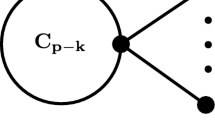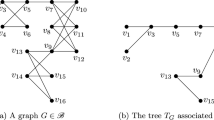Abstract
We prove that graphs following the model of Barabasi–Albert tree with n vertices are hypoenergetic in the large n limit.






Similar content being viewed by others
References
Albert, R., Barábasi, A.: Statistical mechanics of complex networks. Rev. Mod. Phys. 74(47), 47–97 (2002). arXiv:cond-mat/0106096
Albert, R., Barábasi, A.: Emergence of scaling in random networks. Science 286(5439), 509–512 (1999). arXiv:cond-mat/9910332
Arizmendi, O., Juarez-Romero, O.: On bounds for the energy of graphs and digraphs. In: Contributions of Mexican Mathematicians Abroad in Pure and Applied Mathematics (vol. 709, pp. 1–19). Sociedad Matemática Mexicana, American Mathematical Society (2018)
Bollobás, B., Riordan, O., Spencer, J., Tusnády, G.: The degree sequence of a scale-free random graph process. Random Struct. Algorithms 18, 279–290 (2001). https://doi.org/10.1002/rsa.1009
Brouwer, A.E., Haemers, W.H.: Spectra of Graphs. Springer Science and Business Media, Berlin (2012)
Diestel, R.: Graduate texts in mathematics. Graph theory, 173 (2000)
Gutman, I.: The Energy of a graph. Berichte der Mathematische Statistischen Sektion im Forschungszentrum Graz. 103, 1–22 (1978)
Gutman, I.: The energy of a graph: old and new results. In: Algebraic combinatorics and applications (pp. 196–211). Springer, Berlin (2001)
Gutman, I.: On graphs whose energy exceeds the number of vertices. Linear Algebra Appl. 429(11), 2670–2677 (2008)
Koolen, J.H., Moulton, V.: Maximal energy graphs. Adv. Appl. Math. 26, 47–52 (2001)
Koolen, J.H., Moulton, V.: Maximal energy bipartite graphs. Graphs Comb. 19(1), 131–135 (2003)
Krapivsky, P.L., Redner, S., Leyvraz, F.: Connectivity of growing random networks. Phys. Rev. Lett. 85, 4629–4632 (2000)
Krapivsky, P.L., Redner, S.: Organization of growing random networks. Phys. Rev. E 63(6), 066123 (2001)
Li, X., Shi, Y., Gutman, I.: Graph Energy. Springer Science & Business Media, Berlin (2012)
McClelland, B.: Properties of the latent roots of a matrix: the estimation of $\pi $-electron energies. J. Chem. Phys. 54(2), 640–643 (1971)
Nikiforov, V.: The energy of graphs and matrices. J. Math. Anal. Appl. 326(2), 1472–1475 (2007)
Nikiforov, V.: Remarks on the energy of regular graphs. Linear Algebra Appl. 508, 133–145 (2016)
Zhou, B., Gutman, I., de la Peña, J.A., Rada, J., Mendoza, L.: On spectral moments and energy of graphs. MATCH Commun. Math. Comput. Chem. 57, 183–191 (2007)
Funding
Funding was provided by CONACyT (CB-2017-2018-A1-S-976).
Author information
Authors and Affiliations
Corresponding author
Additional information
Publisher's Note
Springer Nature remains neutral with regard to jurisdictional claims in published maps and institutional affiliations.
Appendix 1: Number of neighbors with degree 2
Appendix 1: Number of neighbors with degree 2
Let us denote by \(n_{kl}\), the proportion of edges that connect a pair of nodes of degrees k and l with \(k\le l\) in our graph G. In [13] it was proven that as \(n\rightarrow \infty \) we have
In particular, \(E(n_{2,2})=\frac{1}{45}+o(1)\).
In this appendix we prove that with probability tending to 1, as \(n\rightarrow \infty \) we have
which is required in the proof or our main theorem. More precisely, we will prove the following theorem
Theorem A.1
Let \(T_n\) be a Barabasi–Albert tree on n vertices and let \(n_{2,2}(n)\) the number of edges connecting two vertices of degree 2. Then
as n tends to infinity.
We follow the strategy of [4] by using Azuma–Hoeffding inequality.
Proposition A.2
(Azuma–Hoeffding inequality) Let \((X_t)_{t=0}^n\) be a martingale with respect to the filtration \(\mathcal {F}_t\). Assume that there are predictable processes \((A_t)\) and \((B_t)\) (i.e., \(A_t, B_t \in \mathcal {F}_{t-1}\)) and a constant \(0< c < + \infty \) such that for all \(t \ge 1\), almost surely
and
Then for all \(\beta > 0\)
To prove the claim we will build a martingale \((X_n)^n_{i=0}\), such that \(X_n=n_{2,2}(n)\), \(X_0=E(n_{2,2})\approx 1/45\) and \(|X_i-X_{i-1}|\le 4/n\). If this is the case then by applying the Azuma–Hoeffding inequality to \(X_n\) with \(c=4/n\) and \(\beta =\sqrt{\log n}\) we obtain
which together with the fact the \(E(X_n)\approx 1/45\), as \(n\rightarrow \infty \), give the desired result.
To construct such martingale we consider the Barabasi–Albert tree \(T_t\) as embedded in the process \(\{T_t\}_{i\ge 0}\), where \(T_{t}\) is built from \(T_{t-1}\) by adding joining the vertex \(v_t\) to the vertex \(v_i\) with probability proportional to \(\mathrm{{deg}}(v_i)\) as described above.
Now let \(\mathcal {F}_t\) be the \(\sigma \)-algebra generated by \(\{T_1,...T_t\}\). We claim that \(X_t=E(n_{2,2}(n)|F_t)\) satisfies the above properties. The fact that it is a martingale with \(X_n=n_{2,2}(n)\) and \(X_0=E(n_{2,2}(n))\) is clear. So the main thing to check is the \(|X_{t}-X_{t+1}|\le 4\). To see this note as in [4] that whether at stage t we join \(v_t\) to \(v_i\) or \(v_j\) does not affect the degrees at later times of vertices \(v_k\), \(k\notin \{i,j\}\).
More precisely, the joint distribution of all other degrees is the same in either case.
So we are only interested in the number of vertices v attached to \(v_i\) or \(v_j\) with degree 2, provided that \(v_i\) or \(v_j\) have degree 2. There are at most 2 such vertices for in either case and thus, choosing \(v_i\), instead of \(v_j\) changes the number of edges joining vertices of degree 2 in at most 4 and then \(n_{22}(n)\) changes in at most 4/n. Thus \(|X_t-X_{t+1}|\le 4/n\) as desired.
Rights and permissions
Springer Nature or its licensor holds exclusive rights to this article under a publishing agreement with the author(s) or other rightsholder(s); author self-archiving of the accepted manuscript version of this article is solely governed by the terms of such publishing agreement and applicable law.
About this article
Cite this article
Arizmendi, O., Dominguez, E. Barabasi–Albert trees are hypoenergetic. Bol. Soc. Mat. Mex. 28, 72 (2022). https://doi.org/10.1007/s40590-022-00465-0
Received:
Accepted:
Published:
DOI: https://doi.org/10.1007/s40590-022-00465-0




